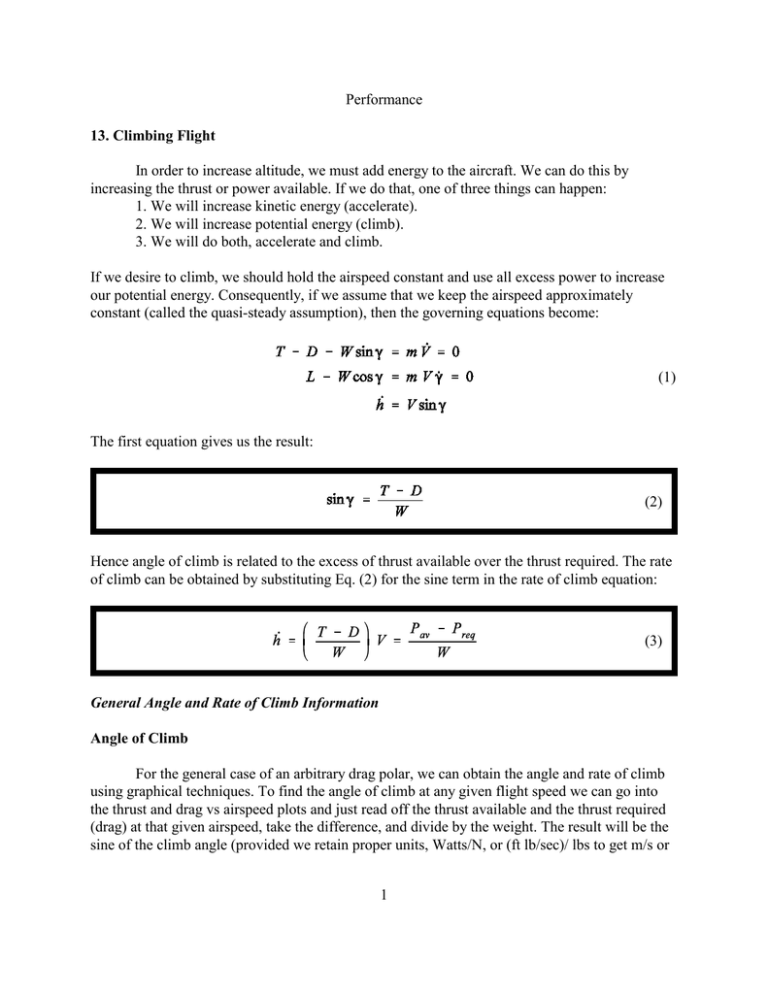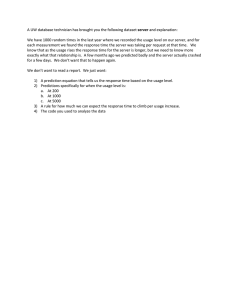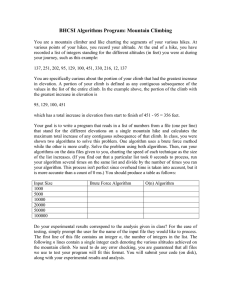Climbing Flight Performance: Angle & Rate of Climb
advertisement

Performance 13. Climbing Flight In order to increase altitude, we must add energy to the aircraft. We can do this by increasing the thrust or power available. If we do that, one of three things can happen: 1. We will increase kinetic energy (accelerate). 2. We will increase potential energy (climb). 3. We will do both, accelerate and climb. If we desire to climb, we should hold the airspeed constant and use all excess power to increase our potential energy. Consequently, if we assume that we keep the airspeed approximately constant (called the quasi-steady assumption), then the governing equations become: (1) The first equation gives us the result: (2) Hence angle of climb is related to the excess of thrust available over the thrust required. The rate of climb can be obtained by substituting Eq. (2) for the sine term in the rate of climb equation: (3) General Angle and Rate of Climb Information Angle of Climb For the general case of an arbitrary drag polar, we can obtain the angle and rate of climb using graphical techniques. To find the angle of climb at any given flight speed we can go into the thrust and drag vs airspeed plots and just read off the thrust available and the thrust required (drag) at that given airspeed, take the difference, and divide by the weight. The result will be the sine of the climb angle (provided we retain proper units, Watts/N, or (ft lb/sec)/ lbs to get m/s or 1 ft/sec). To find the maximum climb angle we must find the location on the graph where the biggest distance between thrust available and thrust required is located. Hence for the general case: Then, for example, at speed V1 we can read off the graph T1 and D1 and can compute the angle of climb at that speed as Also by trial and error, (and a pair of dividers) we can look at the differences of the two curves and determine at what speed the distance is the greatest. That speed will be the max angle of climb speed with the corresponding value of being the max angle of climb. Special Case - Thrust is Constant with Airspeed For the case where thrust is constant with airspeed, the maximum angle of climb occurs at the minimum drag flight condition. Rate of Climb In a similar manner, we can determine the maximum rate of climb using the power available, power required vs airspeed curves. Again, we must use proper units to arrive at the correct result. At any given airspeed we can go into the plot and find the power available and power required, take the difference and divide by the weight and obtain the rate of climb. We can also get this information from the thrust required and thrust available curves by taking their difference at a given airspeed, multiplying it by the airspeed, and dividing by the weight. Obviously it is more convenient to extract the information from the power curves. The figure at the right shows two special cases of the power available curves. One for the case of power being independent of speed (such as a piston engine), and the other the power available for an engine whose thrust is independent of speed (such as a jet). The two velocities indicated represent the conditions for max rate of climb for the constant power case, and the constant thrust case respectively. For the special case of power = constant, the maximum rate of climb occurs at the minimum power condition. 2 Note that each of these graphs is for a given altitude, throttle setting, and weight. If any one of those parameters changes, then the graph changes. Consequently, we can determine the rate (or angle) of climb at any given altitude and airspeed. Furthermore, we can determine the best rate of climb, and the airspeed for the best rate of climb at each altitude. The cross plot of altitude vs. airspeed for best rate of climb tells us how airspeed changes with altitude for best rate or V(h)best R/C. This is called the climb schedule for max R/C. (R/C - rate of climb). Analytic Considerations for Determining Airspeed for Best Rate of Climb For a given weight a throttle setting, the thrust and drag, and power available and power required are functions of altitude and velocity, , and . At a specific altitude, thrust and drag depend on airspeed only. Consequently we can pose the problem of maximizing the rate of climb at a given altitude in the following way: (4) which at a given altitude will be a function of V only. Then the airspeed for maximum rate of climb is given by the solution to the equation: (5) In order to solve this equation, we would need the mathematical models for T and D. As you might suspect, there are special cases where we can find the solution to Eq. (5), either directly or by taking another approach. Special Case Thrust equals a Constant, Parabolic Drag Polar If we assume thrust is independent of airspeed, we can actually solve Eq. (5) for the best rate of climb airspeed. For the case that thrust is a constant with airspeed, , and the above equation becomes (after clearing the W): (6) For this special case we have: and 3 Then substituting into Eq. (6) we have: The quadratic formula yields: Airspeed for maximum rate of climb for the case where thrust is independent of airspeed (7) where; and As with previous discussions, there are alternate ways to arrive at similar results. Here we want to focus on coefficients, to keep the numbers involved more “friendly.” We can write the rate of climb as: We can take the derivative of The result is (after a little algebra): with respect to the lift coefficient and set it equal to zero. 4 Or for max rate of climb assuming thrust independent of airspeed (7) Example Consider our executive jet, W = 10,000 lbs, S - 200 ft2, T = 2,000 lbs and the parabolic drag polar is, . Find the max angle of climb, and the climb rate under that condition, and find the max rate of climb, and the angle of climb under that flight condition. Max Angle of Climb The max angle of climb occurs when the following is a maximum: since T/W is a constant, is a maximum when is a minimum, (or L/Dmax). ( 5 ) Then the rate of climb is Max Rate of Climb Since thrust is a constant and we have a parabolic drag polar, we can use Eq. (17) to find the best rate of climb CL. The max rate of climb angle is less than the max angle of climb (of course) but the airspeed is much higher. Special Case: Power Available Constant with Airspeed, Parabolic Drag Polar Maximum Rate of Climb For the special case where the power available is independent of airspeed, the maximum rate of climb occurs at the minimum power required flight condition, since that would be the condition where the difference in the power available (const) - power required would be the largest. Maximum Angle of Climb For the case of constant power available, we can determine an analytic procedure to solve 6 of the max angle of climb flight conditions. Unfortunately, as we will see, the result is not as nice as previous results. The expression for the angle of climb for an aircraft with constant power output is: (Assuming the small angles L = W) Now we can substitute for the airspeed V where . We can now take the derivative of sin with respect to the lift coefficient and set it equal to zero. or Constant power, parabolic drag polar, maximum angle of climb (8) You could think of this as a quartic equation in , . Summary Cross Plots The basic graph is the power available, power required vs airspeed. From this graph we can solve the equation T = D by looking at the intersections of the curves at the various altitudes. From these solutions, we can then do a cross plot of altitude vs airspeed (maximum and minimum) . On this same plot, we must add the stall speed curve and pick the maximum of the 7 stall speed and the thrust limited minimum speed as the low speed side of the flight envelope. From the basic plot we can determine the airspeed for the maximum rate of climb at each altitude. We can add the locus of these points to the altitude vs airspeed plot. This curve represents the airspeed- altitude schedule for the maximum rate of climb. From the basic plot we can measure the difference in power available and power required and by dividing by the weight, can determine the rate of climb. Where this difference is the greatest, is of course the maximum rate of climb. We can make a cross plot of altitude vs the maximum rate of climb. Generally this curve will be nearly a straight line. Generally we extrapolate the line to intersect the h axis where the R/C = 0. The intersection of this curve with the h axis is called the absolute ceiling. Hence we can suggest an alternate definition of the absolute ceiling: Definition - Absolute Ceiling The absolute ceiling is the altitude at which the (maximum) rate of climb goes to zero. A more useful definition is the service ceiling Definition - Service Ceiling The service ceiling is the altitude at which the maximum rate of climb is 100 ft/min. ( 0.5 m/s) for piston powered aircraft or 500 ft/min (2.5 m/s) for jet powered aircraft. Definition - Cruise Ceiling The cruise ceiling is the altitude at which the maximum climb rate is 300 ft/min Definition - Combat Ceiling The combat ceiling is the altitude at which the maximum rate of climb is 500 ft/sec or 2.5 m/s. Sometimes this is called a “service ceiling” for jet powered aircraft. Time to Climb Between Two Altitudes The time to climb between two altitudes can be determined from the following: (9) or 8 (10) However, in order to evaluate the above integral, we need to know V(h) and (h) or in general, the rate of climb as a function of altitude. From the basic power available, power required vs airspeed plots, we can determine the rate of climb provided we select an airspeed. For each speed we get a different rate of climb ( ). Typically, we would select a speed for the maximum rate of climb. Whatever the case, the selected speed at each altitude is called the “climb schedule,” V(h). Once we have V(h), from the basic power required, power available vs airspeed plots we could determine and in principle could carry out the integral of Eq. (10). However we can make some approximations that will allow us to get a very good estimate of time to climb. Approximate Methods for Estimating the Time to Climb Generally we must select a climb schedule and then generate a plot of altitude (h) vs rate of climb (R/C). Typical climb schedules would be climb at constant airspeed, climb at constant Mach number, climb at constant equivalent airspeed, and climb at the airspeed for maximum rate of climb. All of these would generate a V(h) climb schedule and one could obtain and plot . If we are lucky, the curve will be close to a straight line. If we are less lucky, the we can approximate the curve of h vs R/C with a series of straight lines. In any case if we assume a straight line (or straight line segments) we can determine a closed form evaluation of the integral in Eq. (9). Each straight line segment will intersect the x axis (R/C axis) at some point , and the y axis (h axis) at some point , the straight line ceiling. Therefore associated with each straight line segment is the straight line ceiling, H, and the straight line sea-level rate of climb, . From these, we can write the equation for a straight line to represent the rate of climb over that straight line segment. (11) where the slope is determined from: 9 The integral of Eq. (10) can now be evaluated. If we multiply and divide by H, the integral can be put in the form of dx / (1-x), and can be integrated to give (12) We can determine the values of H and if we know two points on our approximating straight line on the h vs R/C curve. Recall that we can approximate the actual altitude vs rate of climb curve with several straight line segments. Each segment will have its own value of H and . If we know two points on any straight line segment, we can determine the values of H and from the following equations. Assume that we know the data from two points, (a) and (b). The information we can read off the graph (or is given) is, at point a, the altitude, of climb, , and the corresponding information at point (b), the two constants H and , and the rate . Then we can determine , from: (13) Example: Using a single straight line to approximate the altitude vs rate of climb curve, find the time to altitude from sea-level for our “class executive jet” using a “maximum rate of climb” schedule. The aircraft parameters are W = 10,000 lbs, , S = 200 ft2, and the thrust = 2000 lbs at sea-level. 10 Our plan to solve this problem is to calculate the maximum rate of climb properties at two altitudes, use Eq. (13) to determine the two constants H and , and Eq. (12) to calculate the time to climb between any two altitudes. Sea-Level Maximum R/C Conditions Since this problem falls into the category of the special case, we can use Eq. (7) to calculate the maximum rate of climb conditions. The lift coefficient for the maximum, rate of climb is given by: and the corresponding drag coefficient by: The airspeed for the maximum rate of climb is: The flight path angle is given by: (note if comes out to be a small angle!) The rate of climb (maximum) at sea-level is then given by: (2665 ft/min) 11 Maximum R/C Conditions at 20,000 ft The thrust available at 20,000 ft is given by: The lift coefficient for the maximum climb rate at 20K ft is: with the corresponding drag coefficient: the corresponding airspeed: and angle of climb: The corresponding rate of climb is given by: We now have conditions at two points, and, assuming a straight line, we can calculate the two constants . Designate the sea-level conditions as (a), and the 20,000 ft conditions as (b) and we have: and 12 . Then (As might be expected) and Since we are using a single straight line to approximate our altitude vs R/C curve, this H is an approximation of the ceiling of this aircraft. The time from sea-level ( h1 = 0) to any altitude can be computed from: We can compute the time to our favorite altitude and make a table: We can also calculate the service ceiling using the definition that for a jet it is when the rate of climb becomes 500 ft/min. We have the equation for the rate of climb, Eq. (10): h(1000 ft) t(sec) t(min) 0 0 0 5 122.5 2.04 10 270.2 4.50 15 456.2 7.60 20 707.9 11.80 25 1098.3 18.31 30 2016.0 33.60 You could redo the above problem using two different points such as h = 10000 ft and h = 20000 ft and see how the choice of points would affect the time to climb numbers. Or, if you are a real glutton for punishment, pick two straight line segments, say ha = sea--level and hb = 15,000 ft for one segment, and ha = 15,000 ft and hb = 30,000 ft for the second segment. To make a table similar to the one above, you would use the first line segment to calculate all times from 13 sea-level to any altitude below (or equal to) 15,000 ft. and you would use the second segment to calculate all times for 15,000 ft to all altitudes above 15,000. To get the time from sea-level, you would add the time from sea-level to 15,000 ft calculated using the first segment, to the time calculated from 15,000 ft to altitudes between 15,000 and the ceiling (which will be different from above). 14


